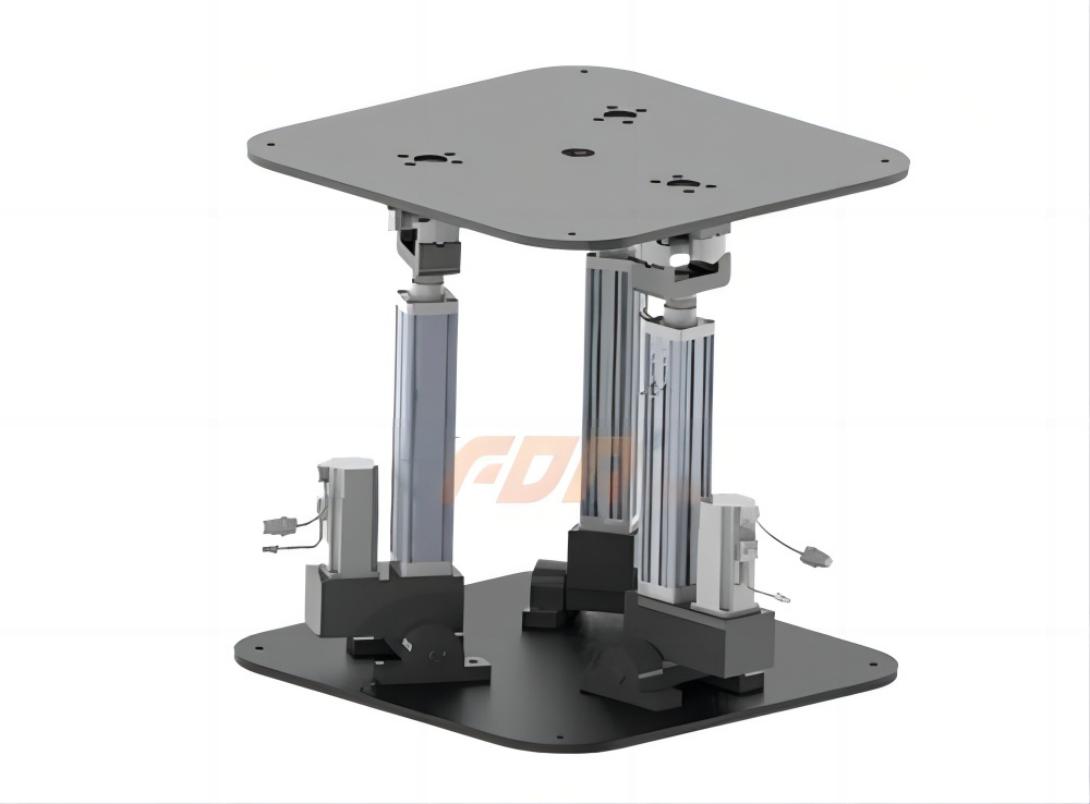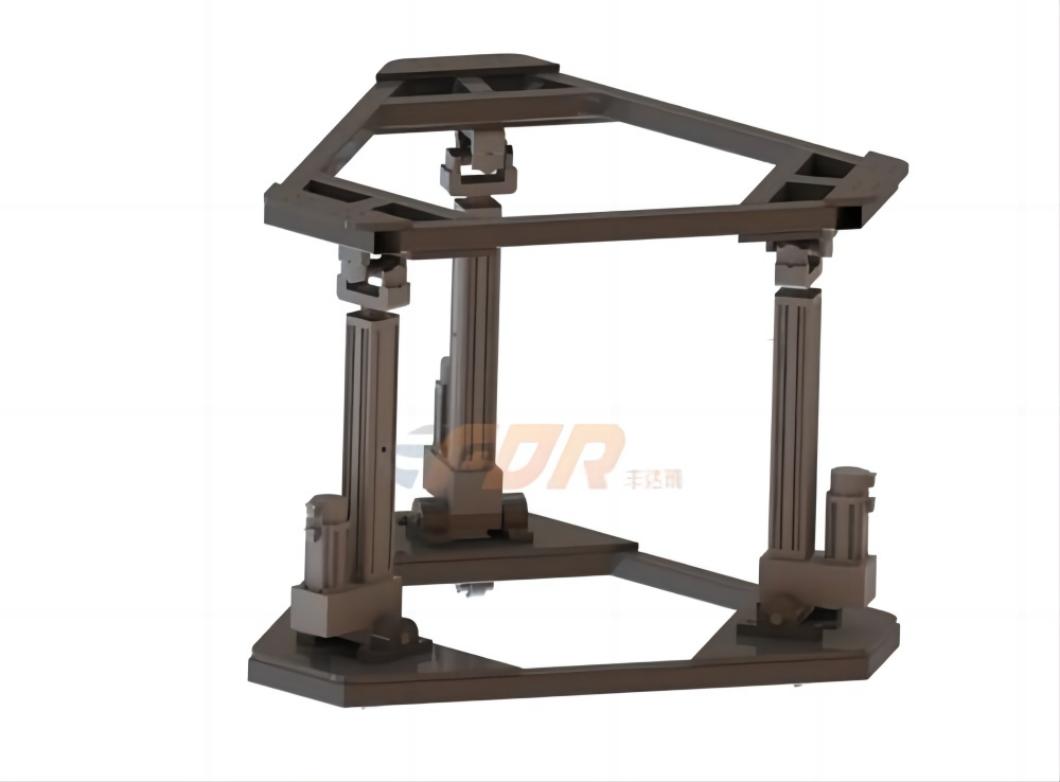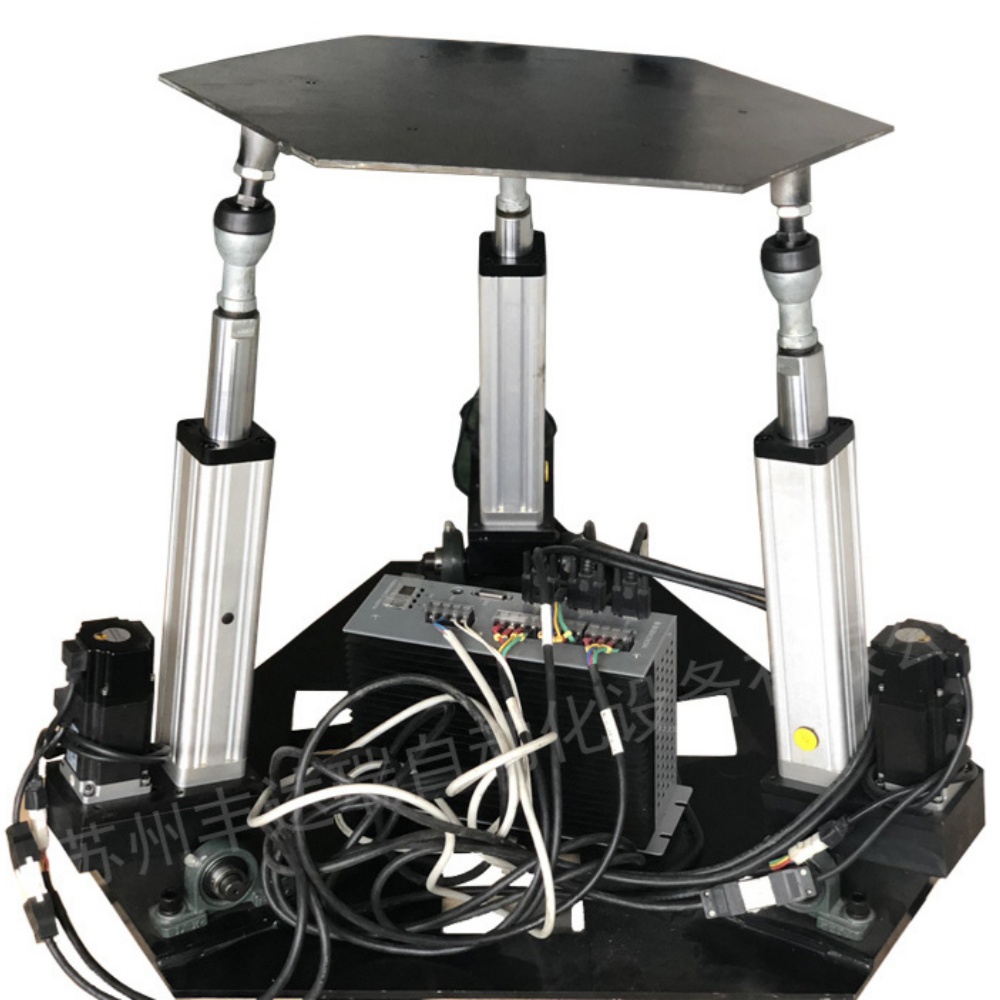
Ever wondered how motion simulators create such realistic experiences? Enter the world of 3DOF motion platforms. These platforms offer movement along three axes: roll, pitch, and heave. They play a crucial role in simulation and training, providing immersive experiences without the complexity of 6DOF systems. In this post, you'll learn about the mechanics, applications, and benefits of 3DOF motion platforms.
Understanding the Mechanics of 3DOF Motion Platforms
A 3DOF motion platform provides movement along three specific axes: roll, pitch, and heave. These axes define the core mechanics that allow the platform to simulate realistic motion for various applications.
Axes of Movement: Roll, Pitch, and Heave
Roll: Rotation around the longitudinal axis, tilting side to side like a boat rocking.
Pitch: Rotation around the lateral axis, tilting forward and backward, similar to a plane’s nose moving up or down.
Heave: Vertical translation, moving up and down to simulate elevation changes or bumps.
These three movements combine to create a convincing sense of motion, especially for scenarios like driving or sim racing where full six degrees of freedom are not necessary.
Components and Technology Involved
A typical 3DOF motion platform includes:
Servo motors or actuators: Provide precise control of movement on each axis.
Frame and platform structure: Supports payloads such as seats or cockpits.
Sensors: Include inertial measurement units (IMUs) and encoders to monitor position and velocity.
Control electronics: Process input commands and regulate motor outputs.
Safety systems: Emergency stops and braking mechanisms ensure operational safety.
These components work together to deliver smooth, responsive motion.
How 3DOF Motion is Achieved
The platform’s actuators adjust the position of the top platform by rotating or translating along the roll, pitch, and heave axes. For example:
To simulate a left turn, the platform rolls to the left.
When accelerating uphill, it pitches backward and moves upward (heave).
To mimic road bumps, the platform quickly moves up and down along the heave axis.
This coordinated movement creates realistic feedback that aligns with visual and auditory cues.
Control Systems and Feedback Loops
3DOF motion platforms rely on closed-loop control systems. These systems continuously compare the desired position with the actual position using sensor feedback. The controller adjusts actuator commands to minimize errors, ensuring accurate and stable motion.
Common control approaches include:
PID (Proportional-Integral-Derivative) controllers for precise response.
Analog or digital signal inputs from simulation software.
Integration with APIs for motion synchronization.
This tight feedback loop is crucial for maintaining realism in motion simulation.
Customization and Flexibility
3DOF platforms offer a high degree of customization to fit specific needs:
Payload capacity: Ranges from small setups for gaming seats to large platforms supporting multiple users.
Platform size and shape: Adjustable to accommodate different equipment.
Motion range and speed: Tuned to simulate various intensities of motion.
Control interface: Compatible with diverse software and hardware environments.
This flexibility allows 3DOF motion platforms to serve a broad spectrum of industry applications, from entertainment to professional training.
Tip: When setting up a 3DOF motion platform, ensure your control system includes real-time feedback loops to maintain precise and responsive motion, crucial for effective simulation performance.

Applications of 3DOF Motion Platforms
3DOF motion platforms are widely used across various industries due to their ability to simulate realistic movement along three axes: roll, pitch, and heave. Understanding 3dof systems helps reveal why these platforms are popular for many motion simulation platform uses.
Sim Racing and Driving Simulators
One of the most common 3dof motion platform applications is sim racing and driving simulators. These platforms replicate the key motions experienced while driving, such as tilting during turns (roll), pitching when accelerating or braking, and vertical movement over bumps (heave). This level of motion simulation enhances immersion without the complexity or cost of 6DOF systems. Racing enthusiasts and professional drivers alike benefit from the realistic feedback, improving skill acquisition and reaction times.
Flight Simulation and Pilot Training
While advanced flight simulators often require 6DOF platforms for full rotational and translational movement, 3DOF motion platforms still play a role in pilot training. They provide essential motion cues like roll and pitch, which are critical for basic flight maneuvers. These platforms serve as cost-effective training tools, especially for initial instruction or systems where full 6DOF motion is unnecessary. The controlled motion feedback helps pilots develop spatial awareness and control skills.
Entertainment and Virtual Reality Experiences
In entertainment, 3DOF motion platforms are popular for VR rides, gaming chairs, and immersive experiences. They provide dynamic motion cues that align with virtual content, making games and simulations more engaging. The platforms’ ability to simulate motion without extensive space or power requirements suits theme parks and home VR setups. By integrating 3dof motion technology with VR headsets, users feel more physically connected to the virtual environment, enhancing realism and reducing motion sickness.
Medical Testing and Rehabilitation
The medical field uses 3DOF motion platforms for patient testing and rehabilitation exercises. These platforms simulate controlled movements to assess balance, coordination, and motor response. In rehabilitation, they help patients regain strength and stability by providing adjustable motion patterns tailored to therapy goals. The precise control and feedback loops in 3dof motion control systems allow clinicians to customize treatments and monitor progress effectively.
Military and Defense Training
Military training benefits from 3DOF motion platforms by simulating vehicle and equipment operation under realistic conditions. These platforms create immersive training scenarios for soldiers, vehicle operators, and pilots, enhancing situational awareness and decision-making skills. The balance of cost-effectiveness and sufficient motion realism makes 3DOF systems ideal for many defense applications where full 6DOF is not mandatory. They also support integration with VR systems to simulate combat environments safely.
Tip: When selecting a 3DOF motion platform for your application, consider the specific motion cues your training or simulation requires to optimize immersion and cost-effectiveness.

Benefits of Using 3DOF Motion Platforms
Using a 3DOF motion platform offers several compelling advantages, especially when compared to more complex systems like 6DOF platforms. These benefits make 3DOF platforms a popular choice across many industries, from training simulators to entertainment and medical applications.
Enhanced Realism and Immersion
A 3DOF motion platform enhances the realism of simulations by providing physical movement cues along the roll, pitch, and heave axes. This physical feedback aligns with visual and auditory stimuli, making experiences more immersive. For example, in sim racing, the platform tilts and moves to mimic the sensations of turning, accelerating, or driving over bumps. This synchronization between motion and visuals deepens user engagement and helps create a convincing sense of presence.
Moreover, in virtual reality setups, 3DOF motion technology reduces the disconnect between what users see and what they physically feel. This improved sensory alignment leads to a more believable experience without the need for the full complexity of 6DOF systems.
Cost-Effectiveness Compared to 6DOF
One of the main benefits of 3DOF platforms is their cost-effectiveness. They require fewer actuators and simpler control systems than 6DOF platforms, which translates to lower manufacturing and maintenance costs. This makes 3 dof platform benefits especially attractive for organizations with budget constraints or those seeking a balance between performance and price.
In industries like sim racing or basic pilot training, where full six degrees of freedom aren’t critical, 3DOF platforms provide an economical solution without sacrificing essential motion simulation quality.
Improved Training Effectiveness
3DOF motion platforms contribute significantly to improved training outcomes. By physically replicating key motion cues, they help trainees develop better spatial awareness and motor skills. For instance, flight and driving simulators using 3DOF motion control systems allow users to experience realistic tilting and elevation changes, which are crucial for understanding vehicle dynamics.
This tactile feedback enhances muscle memory and decision-making skills, making training more effective and transferable to real-world scenarios.
Reduced Motion Sickness in VR
Motion sickness is a common challenge in virtual reality experiences, often caused by a mismatch between visual motion cues and the lack of physical movement. A 3DOF motion platform helps mitigate this issue by providing synchronized physical motion along three axes.
By moving the user’s body in coordination with the VR content, the platform reduces sensory conflict, which lowers the chances of nausea and discomfort. This benefit is particularly important in extended VR training or entertainment sessions, improving user comfort and overall experience.
Tip: When evaluating 3DOF motion platform benefits, consider how the platform’s ability to deliver synchronized physical feedback can enhance immersion and reduce motion sickness, offering a cost-effective alternative to more complex systems.
Challenges and Limitations of 3DOF Motion Platforms
While 3DOF motion platforms offer many advantages, they also come with certain challenges and limitations that users and developers must consider when integrating them into simulation or training environments.
Limited Rotational Movement
A primary limitation of 3DOF systems is their restricted range of motion. They provide rotational movement along roll and pitch axes, plus vertical translation (heave), but lack yaw rotation and lateral or longitudinal translation. This limitation means they cannot fully replicate complex real-world motions that involve turning left or right (yaw) or moving side to side and forward/backward without rotation.
For example, in flight simulation or advanced driving scenarios, yaw rotation is critical for realistic maneuvering. Without it, some motion cues may feel missing or less convincing. This constraint affects the fidelity of motion simulation, especially in applications demanding full six degrees of freedom.
Space and Portability Concerns
Though generally more compact than 6DOF platforms, 3DOF motion platforms still require a dedicated physical footprint. The size depends on payload capacity and motion range. Larger platforms supporting multiple users or heavier equipment can be bulky and less portable.
This poses challenges for facilities with limited space or those needing mobile setups. Additionally, heavier platforms may require reinforced flooring and specialized installation, increasing setup complexity and cost. Portability is further limited by the need for power supplies and control hardware, which may not be easily moved.
Complexity in Integration with VR Systems
Integrating a 3DOF motion platform with virtual reality (VR) systems introduces technical challenges. The platform’s movements must synchronize precisely with VR visuals to maintain immersion and prevent motion sickness.
Motion compensation is often necessary because VR headset tracking systems may not account for the platform’s physical movement. Achieving seamless integration requires sophisticated software, APIs, and sometimes external sensors like IMUs or optical trackers to relay accurate motion data to the VR system.
Furthermore, some platforms lack built-in tracking capabilities, making it harder to implement real-time feedback loops. This complexity can increase development time and costs in VR applications.
Maintenance and Calibration Needs
Maintaining a 3DOF motion platform involves regular calibration and servicing to ensure accurate and reliable motion control. Actuators, sensors, and control electronics can drift or degrade over time, affecting performance.
Calibration routines must verify that the platform’s actual position matches commanded positions on all three axes. Without proper maintenance, motion fidelity declines, reducing the effectiveness of training or simulation.
Additionally, mechanical components such as bearings and joints require inspection and lubrication. Neglecting maintenance can lead to increased downtime and costly repairs.
Tip: When planning a 3DOF motion platform setup, assess your application’s motion requirements carefully to balance system limitations with space, integration complexity, and maintenance capabilities for optimal performance.
Future Developments in 3DOF Motion Platform Technology
The technology behind 3DOF motion platforms continues to evolve rapidly, driven by advancements in sensors, artificial intelligence, and user experience design. These developments promise to expand the capabilities and applications of 3dof motion platforms, making them more versatile and effective across industries.
Advancements in Sensor Technology
Modern 3DOF motion platforms benefit from improved sensor accuracy and responsiveness. Inertial Measurement Units (IMUs), which combine accelerometers, gyroscopes, and magnetometers, have become smaller, more precise, and more affordable. These sensors enhance the platform’s ability to detect subtle movements and provide real-time feedback, improving motion platform mechanics and control.
Enhanced sensor fusion techniques allow platforms to better interpret complex motion data, reducing latency and jitter. This leads to smoother, more realistic motion simulation platform uses, especially important in training and VR applications where timing and accuracy are critical.
Integration with AI and Machine Learning
Artificial intelligence is playing an increasing role in motion control systems. By analyzing user behavior and environmental data, AI algorithms can optimize motion profiles dynamically. This means a 3DOF motion platform can adapt its responses to individual users or specific scenarios, improving immersion and effectiveness.
Machine learning models can predict motion needs based on prior data, enabling pre-emptive adjustments that reduce lag and enhance realism. Integration with AI also supports predictive maintenance by detecting wear or calibration drift early, reducing downtime and maintenance costs.
Potential for Broader Applications
As 3dof motion technology advances, new industry applications are emerging. Beyond traditional uses like sim racing and pilot training, 3DOF platforms are being explored for:
Remote robotic control, providing operators with tactile feedback.
Advanced medical rehabilitation, where adaptive motion aids recovery.
Architectural and engineering visualization, offering immersive walkthroughs.
Theme park rides and immersive entertainment, delivering more engaging experiences.
These broader applications benefit from the platform’s balance of cost-effectiveness and sufficient motion realism.
Trends in User Experience Enhancement
User experience remains a key focus in the development of 3DOF motion platforms. Future trends include:
Improved haptic feedback integration to complement motion cues.
More compact, modular designs for easier setup and portability.
Enhanced software interfaces allowing seamless integration with VR and XR systems.
Greater customization options, letting users tailor motion intensity and range.
These trends aim to make 3DOF platforms more accessible and enjoyable, reducing barriers to adoption in both commercial and professional settings.
Tip: To future-proof your 3DOF motion platform investment, prioritize systems that support advanced sensor integration and AI-driven motion control, ensuring adaptability to evolving industry applications and user expectations.
Conclusion
A 3DOF motion platform simulates motion along roll, pitch, and heave axes, enhancing realism in applications like sim racing and pilot training. Future advancements in sensor technology and AI integration promise broader applications and improved user experiences. The FDR 3DOF platform offers cost-effective, immersive solutions, making it ideal for various industries. Its adaptability and advanced features provide significant value, ensuring users benefit from enhanced motion simulation and training effectiveness.
FAQ
Q: How does a 3DOF motion platform work?
A: A 3DOF motion platform works by providing movement along three axes: roll, pitch, and heave, using servo motors or actuators. This setup allows for realistic motion simulation by adjusting the platform's position based on input commands and sensor feedback.
Q: What are the main applications of a 3DOF motion platform?
A: Main applications include sim racing, driving and flight simulators, virtual reality experiences, medical testing, rehabilitation, and military training. These platforms enhance realism and immersion by simulating key motion cues necessary for various scenarios.
Q: What are the benefits of using a 3DOF motion platform?
A: Benefits include enhanced realism and immersion, cost-effectiveness compared to 6DOF systems, improved training effectiveness, and reduced motion sickness in VR environments. They offer a balance between performance and affordability.
Q: How do 3DOF motion control systems enhance training?
A: 3DOF motion control systems enhance training by providing realistic motion cues that improve spatial awareness and motor skills. This helps trainees develop better muscle memory and decision-making skills, crucial for real-world applications.
















